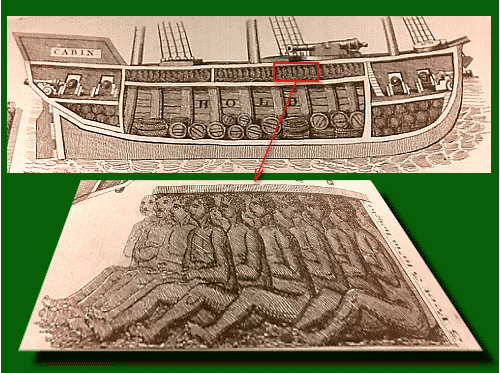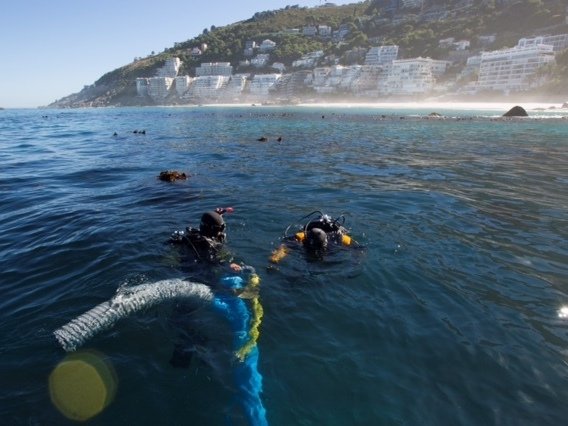São José Paquete Africa on:
[Wikipedia]
[Google]
[Amazon]
 The ''São José Paquete Africa'' (also, ''São José-Paquete de Africa'') was a Portuguese
The ''São José Paquete Africa'' (also, ''São José-Paquete de Africa'') was a Portuguese
 On April 27, 1794, the ''São José'' sailed from
On April 27, 1794, the ''São José'' sailed from
 Local divers found the wreck off of Clifton beach in the 1980s but misidentified it as a Dutch merchant ship. Several items from the ship, including bolts, cannon balls and cannons were removed by treasure hunters. Discoveries in archives in South Africa and Portugal, as well as tests of artifacts confirmed in 2015 that the ship was the ''São José'' slave ship. On June 3, 2015, along with the formal announcement of the find, a memorial service was held for the lost. Three divers from South Africa, the United States, and Mozambique scattered soil from the slaves' homeland in the surf not far from the wreck. Artifacts from the dive site were displayed at the South Africa's
Local divers found the wreck off of Clifton beach in the 1980s but misidentified it as a Dutch merchant ship. Several items from the ship, including bolts, cannon balls and cannons were removed by treasure hunters. Discoveries in archives in South Africa and Portugal, as well as tests of artifacts confirmed in 2015 that the ship was the ''São José'' slave ship. On June 3, 2015, along with the formal announcement of the find, a memorial service was held for the lost. Three divers from South Africa, the United States, and Mozambique scattered soil from the slaves' homeland in the surf not far from the wreck. Artifacts from the dive site were displayed at the South Africa's
Iziko Museum - Slavery in South AfricaSlave Wrecks ProjectSmithsonian - Slave Wrecks program
* {{DEFAULTSORT:Sao Jose Paquete Africa Maritime incidents in 1794 Shipwrecks of the South African Atlantic coast Maritime incidents involving slave ships 2015 archaeological discoveries 1790s ships Portuguese slave ships
 The ''São José Paquete Africa'' (also, ''São José-Paquete de Africa'') was a Portuguese
The ''São José Paquete Africa'' (also, ''São José-Paquete de Africa'') was a Portuguese slave ship
Slave ships were large cargo ships specially built or converted from the 17th to the 19th century for transporting Slavery, slaves. Such ships were also known as "Guineamen" because the trade involved human trafficking to and from the Guinea ( ...
that sank in 1794 off the coast of Cape Town
Cape Town is the legislature, legislative capital city, capital of South Africa. It is the country's oldest city and the seat of the Parliament of South Africa. Cape Town is the country's List of municipalities in South Africa, second-largest ...
, South Africa. Close to shore, but in deep water, 212 of the 400 to 500 African slaves who were aboard died when the ship sank. In 2015, the Smithsonian's African American History Museum, South Africa's Iziko Museums
Iziko Museums of South Africa, formerly Southern Flagship Institution (SFI) and then Iziko Museums of Cape Town, is an organisation governing national museums in greater Cape Town, in the Western Cape province of South Africa. there are 11 mus ...
, the Slave Wrecks Project, and other partners, confirmed discovery of the wreck near where it sank. The ship and its slaves were headed from Portuguese Mozambique
Portuguese Mozambique () or Portuguese East Africa () were the common terms by which Mozambique was designated during the period in which it was a Portuguese Empire, Portuguese overseas province. Portuguese Mozambique originally constituted a str ...
to Colonial Brazil
Colonial Brazil (), sometimes referred to as Portuguese America, comprises the period from 1500, with the Discovery of Brazil, arrival of the Portuguese, until 1815, when Brazil was elevated to a United Kingdom of Portugal, Brazil and the Algarves ...
, during the height of the international African slave trade. Few other former slave ships have been found, but the ''São José'' is the first and only shipwreck discovered, as of June 3, 2015, of a working slave ship, which sank in transit with its human cargo aboard.
History
 On April 27, 1794, the ''São José'' sailed from
On April 27, 1794, the ''São José'' sailed from Lisbon
Lisbon ( ; ) is the capital and largest city of Portugal, with an estimated population of 567,131, as of 2023, within its administrative limits and 3,028,000 within the Lisbon Metropolitan Area, metropolis, as of 2025. Lisbon is mainlan ...
, Portugal, captained by Manuel João Pereira. In its hold were a load of carefully calibrated iron
Iron is a chemical element; it has symbol Fe () and atomic number 26. It is a metal that belongs to the first transition series and group 8 of the periodic table. It is, by mass, the most common element on Earth, forming much of Earth's o ...
ballast
Ballast is dense material used as a weight to provide stability to a vehicle or structure. Ballast, other than cargo, may be placed in a vehicle, often a ship or the gondola of a balloon or airship, to provide stability. A compartment within ...
s that sailing ships required in order to effectively transport on the open ocean the shifting weight of hundreds of individual captive humans. The ship's destination, the Portuguese colony of Mozambique in southeastern Africa, was a relatively new source of slave labor for the Atlantic slave trade. The ''São José'' is one of the first known ships to attempt the long-distance voyage from Portugal to Mozambique to Brazil.
The ship’s path represents European slave traders’ increased efforts to obtain slaves. More than two centuries of slave trade along Africa’s west coast reduced the population, and along with increasing competition, motivated Portugal to send ships 7,000 miles to one of the farthest, cheapest sources of slaves in the trans-Atlantic trade, Mozambique, Africa, and then ship the slaves around the Cape of Africa to Brazil.
In early December, at the port on the Island of Mozambique
The Island of Mozambique () lies off northern Mozambique, between the Mozambique Channel and Mossuril Bay, and is part of Nampula Province. Prior to 1898, it was the capital of colonial Portuguese East Africa.
With its rich history and sandy b ...
, the ship's crew loaded their human cargo and got under way. The enslaved men, women and children were likely from the interior of Mozambique. Their travel in the slave hold to Maranhão
Maranhão () is a States of Brazil, state in Brazil. Located in the country's Northeast Region, Brazil, Northeast Region, it has a population of about 7 million and an area of and it is divided into 217 municipalities. Clockwise from north, it ...
, Brazil, was set to take some four months. The journey lasted only a few weeks.
The ship was attempting to make its way through the difficult waters off the Cape at about 2:00 a.m. December 27. Near Camps Bay
Camps Bay (Afrikaans: ''Kampsbaai'') is an affluent suburb of Cape Town, South Africa, and the small bay on the west coast of the Cape Peninsula after which it is named. In summer it attracts many South African and foreign visitors.
History
The ...
, it ran into submerged rocks about from shore. With the ship in distress, the crew raised the alarm by firing the cannons. A barque
A barque, barc, or bark is a type of sailing ship, sailing vessel with three or more mast (sailing), masts of which the fore mast, mainmast, and any additional masts are Square rig, rigged square, and only the aftmost mast (mizzen in three-maste ...
with some of the human cargo was able to reach the safety of the Cape Colony
The Cape Colony (), also known as the Cape of Good Hope, was a British Empire, British colony in present-day South Africa named after the Cape of Good Hope. It existed from 1795 to 1802, and again from 1806 to 1910, when it united with three ...
. Relays of ropes with baskets were also employed to help save lives but the ship broke into pieces about 5:00. The captain and all the crew were rescued, but hundreds of the slaves drowned, possibly in their iron shackles. The survivors were soon sold in the Cape Colony.
Discovery
 Local divers found the wreck off of Clifton beach in the 1980s but misidentified it as a Dutch merchant ship. Several items from the ship, including bolts, cannon balls and cannons were removed by treasure hunters. Discoveries in archives in South Africa and Portugal, as well as tests of artifacts confirmed in 2015 that the ship was the ''São José'' slave ship. On June 3, 2015, along with the formal announcement of the find, a memorial service was held for the lost. Three divers from South Africa, the United States, and Mozambique scattered soil from the slaves' homeland in the surf not far from the wreck. Artifacts from the dive site were displayed at the South Africa's
Local divers found the wreck off of Clifton beach in the 1980s but misidentified it as a Dutch merchant ship. Several items from the ship, including bolts, cannon balls and cannons were removed by treasure hunters. Discoveries in archives in South Africa and Portugal, as well as tests of artifacts confirmed in 2015 that the ship was the ''São José'' slave ship. On June 3, 2015, along with the formal announcement of the find, a memorial service was held for the lost. Three divers from South Africa, the United States, and Mozambique scattered soil from the slaves' homeland in the surf not far from the wreck. Artifacts from the dive site were displayed at the South Africa's Iziko Museum
The Iziko South African Museum, formerly the South African Museum (Afrikaans: Suid-Afrikaanse Museum), is a South African national museum located in Cape Town. The museum was founded in 1825, the first in the country. It has been on its present ...
's Slave Lodge in June 2015, and undergo conservation efforts there, with additional research and recovery continuing. Some artifacts were loaned for display at the United States' African American History Museum, when it opened in 2016. Connected with the 2015 anniversary of the abolition of slavery in South Africa and the work on the ''Sao Jose'', the Iziko launched a new website exhibition, ''Slavery in South Africa''.
See also
*Shipwrecks of Cape Town
The Shipwrecks of Cape Town are the shipwrecks in the waters of the Atlantic Ocean in the vicinity of Cape Town, South Africa. They include any wreck that is in the waters off the shores of the City of Cape Town metropolitan area. The geographical ...
References
External links
Iziko Museum - Slavery in South Africa
* {{DEFAULTSORT:Sao Jose Paquete Africa Maritime incidents in 1794 Shipwrecks of the South African Atlantic coast Maritime incidents involving slave ships 2015 archaeological discoveries 1790s ships Portuguese slave ships